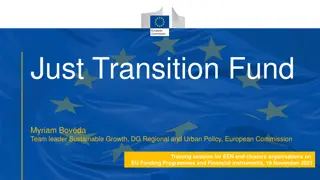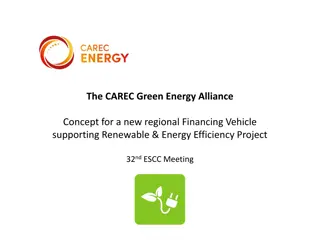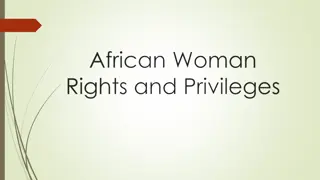Green Energy Transition in Nigeria: Opportunities and Challenges
Nigeria faces challenges in meeting its energy demands, with a large population lacking access to reliable electricity. The transition to green energy sources like solar, biomass, hydro, and wind presents investment opportunities to address these issues. Solar energy potential is high in Nigeria, while biomass resources and hydropower also offer promising avenues for sustainable energy generation. Although wind energy potential is modest, there is localized potential for wind power generation in certain regions. By tapping into these renewable resources, Nigeria can work towards a more sustainable and environmentally friendly energy sector.
Download Presentation

Please find below an Image/Link to download the presentation.
The content on the website is provided AS IS for your information and personal use only. It may not be sold, licensed, or shared on other websites without obtaining consent from the author. Download presentation by click this link. If you encounter any issues during the download, it is possible that the publisher has removed the file from their server.
E N D
Presentation Transcript
Green Energy Transition in Nigeria
Background & Justification
Context With an installed generation capacity (most of it from thermal and hydro sources) of about 13 gigawatts (GW) and a distribution capacity of about 4 GW, the key figures in Nigeria are well below the expected capacity for a population of more than 200 million. The national electrification rate of 56.5% means that over 80 million Nigerians live in areas that have no access to grid electricity. Energy requirements for most off-grid rural communities typically range from small household applications to productive uses across agriculture, trade, and services. Energy demand will continue to rise due to the rapidly growing population and economy. Over the last decades, there has been almost no capacity expansion in the energy sector. As a result of the frequent outages experienced on the grid, most of the country s companies and households are dependent on their own supply of mainly diesel- or petrol-powered generators, with electricity production costs of US$0.24 to US$0.42/kWh compared to US$0.12 to US$0.15/kWh from the power grid. This in turn leads to pollution, higher production costs for companies, and increased living costs for households. 3 9/10/2024
Nigerias natural resources, multiple renewable technologies offer investment opportunities Solar Power Nigeria has enormous solar energy potential, with fairly distributed solar radiation averaging 19.8 MJm2/day and average sunshine hours of 6.25h/day The assumed potential for concentrated solar power and photovoltaic generation is around 427GW According to estimates, the designation of the 5% most suitable land in central and northern Nigeria for solar thermal would provide a theoretical generation capacity of 42.7GW - over 4 times the current Nigerian grid capacity Biomass Power The biomass resources of Nigeria are mainly crops, forage grasses, shrubs, animal wastes and waste arising from forestry, agriculture and municipal and industrial activities According to estimates, the daily production of animal waste in Nigeria is about 227,500 tons, which could produce ~30% of electricity consumed by the grid in 2018. And crops such as sweet sorghum, maize, and sugarcane are the most promising opportunities for biofuel production Though the technology itself is not yet widely established in the country, there are number of successful cases of agri-businesses producing energy for own use with biomass feedstock as well as pilot biomass mini-grids 4 9/10/2024
Nigerias natural resources, multiple renewable technologies offer investment opportunities Hydro Power Hydropower has been a substantial contributor to Nigeria s grid for a number of decades, accounting for ~20% of total grid supply today While large scale hydro power is well established, there is significant untapped potential in small hydropower across Nigeria A multitude of river systems, providing a total of 70 micro dams, 126 mini dam and 86 small sites, supply a technically exploitable capacity of 3.5GW, but only 1.7% (0.06GW) of these resources is currently being tapped Wind Power Wind energy potential in Nigeria is modest compared with other technologies, with annual average speeds of about 2.0 m/s at the coastal region and 4.0 m/s at heights of 30m in the far northern region of the country Wind speed of up to 5m/s were recorded in the most suitable locations, which reveals only a moderate, localized potential for wind energy. 5 9/10/2024
National Projects and Programs
Investments programs Nigeria Vision 30:30:30 supports the implementation of 30,000 MW of installed capacity, with a share of at least 30% renewable energy by 2030, and with targets for installed PV capacity of 2,000 MW by 2020, and 5,000 MW by 2030. The Rural Electrification Agency (REA) is the implementation agency of the Nigerian Government, tasked with the electrification of rural and underserved communities. The REA have developed an Off-Grid Electrification Strategy to provide access to clean and sustainable electricity for millions of Nigerians: Develop 10,000 mini grids by 2023 which will provide power to 14% of the population Deploy 5 million solar standalone systems for residential and SMEs by 2023 The Rural Electrification Fund (REF) has been established to promote expansion of the grid and the development of off-grid electrification; to support investors and stimulate innovative approaches to rural electrification. 7 9/10/2024
Other Investment programs and agencies Nigerian Investment Promotion Commission (NIPC) https://www.greenenergyinvestment.com.ng/ Africa Connect DEG The Off-Grid Energy Access Fund (OGEF) The Green Energy Fund Program Nigerian Energy Support Programme II The Energizing Education Programme (EEP) The Energizing Economies Initiative (EEI) The Nigeria Electrification Project (NEP) The SUNREF program 8 9/10/2024
b +234 817 030 2628 secretary@ebonigeria.org www.ebonigeria.org























